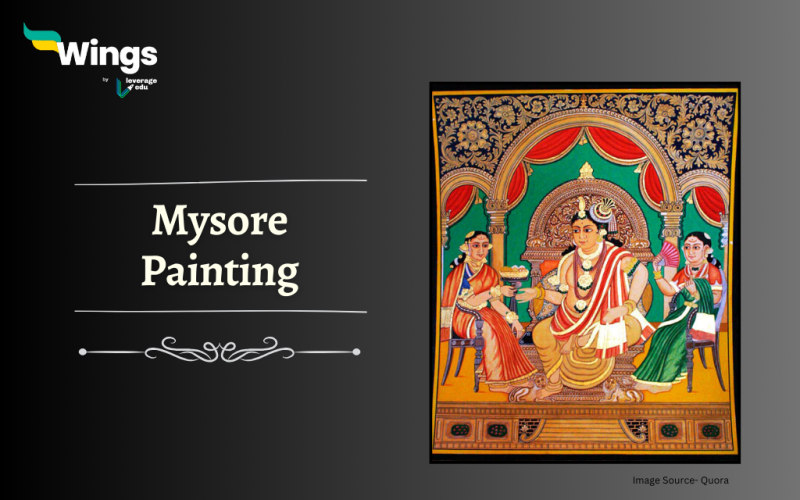In the heart of Karnataka, India, lies a city that resonates with history, tradition, and artistic brilliance – Mysore. Renowned for its rich cultural heritage, Mysore has bestowed a unique and captivating form of art known as Mysore painting, one of the most famous types of Paintings in India. These exquisite artworks are a reflection of the city’s opulent past and the artistry of its people. Mysore paintings are not just artworks; they are windows into a world where tradition meets creativity, and history intertwines with artistic expression. With their intricate detailing, rich colours and captivating themes, these paintings capture the essence of India’s cultural and spiritual heritage.
Table of Contents [show]
History of Mysore Paintings
Mysore painting is thought to have originated in the 17th century, during the reign of the Wodeyar dynasty, which ruled the region for centuries. The Wodeyars were great patrons of the art and they encouraged the development of various art forms, including the distinguished Mysore painting. The art form reached its peak in the 19th century, under the reign of Krishnaraja Wodeyar III.
These paintings are celebrated for their intricate detailing and delicate craftsmanship. They are characterized by their delicate lines, intricate brushstrokes and use of bright vegetable colours and gold leaf. The subjects of these paintings typically depict Hindu gods and goddesses, scenes from Hindu mythology, and other religious themes. However, they can also be used to depict secular subjects such as portraits, landscapes and still lifes.
Also Read- History of Indian Art; Origins, Milestones & Masterpieces.
Techniques and Motifs
Mysore paintings are created using a variety of materials, including paper, wood, and cloth. The first step is to prepare the ground, which is typically done by applying a layer of gesso. The artist then sketches the image onto the ground using a pencil or pen. Once the sketch is complete, the artist begins to fill in the colours. The colours are typically made from vegetable dyes, and they are applied using a variety of brushes. Gold leaf is often used to add accents to the paintings.
These paintings are a labour-intensive art form, and they can take weeks or even months to complete. However, the finished product is a work of beauty that is sure to bring joy to anyone who sees it. They often revolve around Hindu deities, mythological tales, and scenes from epics like the Ramayana and Mahabharata. These themes not only showcase the artists’ mastery but also serve as a medium to preserve and propagate India’s cultural narratives.
Also Read – Traditional Art Forms of India
Common Materials Used
The painters themselves prepare the common materials used in Mysore paintings.
- Interestingly, the colours are extracted from a bunch of natural sources including leaves, stones, and flowers.
- The brushes used in Mysore’s paintings for intricate designs were made from squirrel hairs.
- A special brush are made out of grass for drawing superfine lines without creating a mess.
Characteristics of Mysore Paintings
Some of the characteristics of Mysore paintings are –
- Mysore paintings have small intricate lines and fine brushstrokes.
- They are full of multiple vibrant colours derived from natural sources that are used to complement each other.
- The use of gold leaf to highlight certain aspects such as borders and ornaments is another major characteristic of Mysore paintings.
- As stated earlier, Mysore paintings are generally based on Hindu mythology and religious themes. They depict the lives of gods, royal families, and their courtiers.
Also Read- Famous Painters of India: Life, Work, Style
Legacy and Contemporary Craft
While rooted in tradition, Mysore paintings have evolved over the years. Modern artists have brought innovation to this ancient art form, experimenting with new subjects, styles, and techniques. This evolution has ensured that the paintings remain relevant in today’s world while retaining their timeless charm. Efforts are being made to safeguard the legacy of Mysore paintings. Art institutions, galleries, and workshops in Mysore provide a platform for artists to showcase their talents and keep the tradition alive
Art enthusiasts and collectors from around the globe recognize the cultural and artistic significance of the paintings, contributing to their continued prominence. As we admire the strokes of a Mysore painting, we connect with a legacy that transcends time, enriching our understanding of art and culture and delve ourselves in the stories and symphony of grace and elegance.
Quiz
Results
#1. Mysore Painting has its origin from which state?
#2. In Mysore Paintings which leaves are used very often?
#3. Mysore Painting became famous in whose reign?
The wealth of iconic Indian handicrafts has survived through the centuries. These crafts bear the magnetic attraction of Indian culture, which promises exclusivity, elegance, integrity, and sophistication. For more such interesting and informative topics on Indian History and more, stay tuned to our General Knowledge section.
 One app for all your study abroad needs
One app for all your study abroad needs


















 45,000+ students trusted us with their dreams. Take the first step today!
45,000+ students trusted us with their dreams. Take the first step today!
